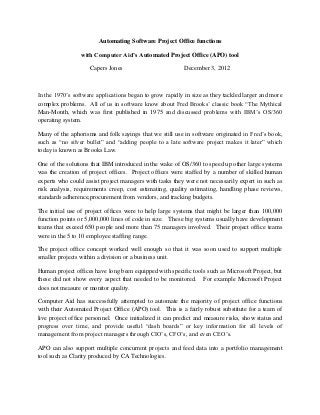
Automating Software Project Office Functions with Computer Aid by Capers Jones
- 1. Automating Software Project Office functions with Computer Aid’s Automated Project Office (APO) tool Capers Jones December 3, 2012 In the 1970’s software applications began to grow rapidly in size as they tackled larger and more complex problems. All of us in software know about Fred Brooks’ classic book “The Mythical Man-Month, which was first published in 1975 and discussed problems with IBM’s OS/360 operating system. Many of the aphorisms and folk sayings that we still use in software originated in Fred’s book, such as “no silver bullet” and “adding people to a late software project makes it later” which today is known as Brooks Law. One of the solutions that IBM introduced in the wake of OS/360 to speed up other large systems was the creation of project offices. Project offices were staffed by a number of skilled human experts who could assist project managers with tasks they were not necessarily expert in such as risk analysis, requirements creep, cost estimating, quality estimating, handling phase reviews, standards adherence,procurement from vendors, and tracking budgets. The initial use of project offices were to help large systems that might be larger than 100,000 function points or 5,000,000 lines of code in size. These big systems usually have development teams that exceed 650 people and more than 75 managers involved. Their project office teams were in the 5 to 10 employee staffing range. The project office concept worked well enough so that it was soon used to support multiple smaller projects within a division or a business unit. Human project offices have long been equipped with specific tools such as Microsoft Project, but these did not show every aspect that needed to be monitored. For example Microsoft Project does not measure or monitor quality. Computer Aid has successfully attempted to automate the majority of project office functions with their Automated Project Office (APO) tool. This is a fairly robust substitute for a team of live project office personnel. Once initialized it can predict and measure risks, show status and progress over time, and provide useful “dash boards” or key information for all levels of management from project managers through CIO’s, CFO’s, and even CEO’s. APO can also support multiple concurrent projects and feed data into a portfolio management tool such as Clarity produced by CA Technologies.
- 2. The APO tool uses standard questionnaires as inputs to collect the initial data for projects. Once collected, the data can be filtered against a rules engine derived from industry best practices to highlight areas that may need improvement. The APO tool also handles a number of human resource topics such as assignments and releases of personnel to specific project activities. Outputs from APO range from high-level executive overviews to detailed risk analyses. APO also has support for project governance. The architecture of APO is not fixed, but allows third-party “cartridges” to be added as needed. Among the more useful outputs are prompts or reminders to key personnel such as project managers as to whether not all deliverables for the current phase have been created, inspected, and approved. A project office staffed by human experts would probably require 5 to 10 fulltime personnel. With Computer Aid’s APO the equivalent in terms of risk assessment and tracking can be done with only one or two personnel supported by the APO software.
